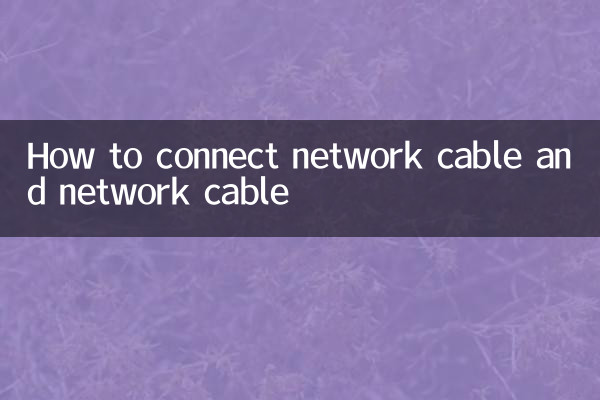How to connect network cable and network cable
In today's era of rapid development of the Internet, network cables are an important carrier of network connections, and their connection methods and usage techniques have attracted much attention. This article will combine the hot topics and hot content on the Internet in the past 10 days to introduce the connection method of network cables in detail and provide structured data for reference.
1. Basic types of network cables

Network cables are mainly divided into the following types, each type is suitable for different network environments and needs:
| Network cable type | Applicable scenarios | Transmission rate |
|---|---|---|
| Cat5 | Home network, small office | 100Mbps |
| Cat5e | Small and medium-sized enterprise network | 1Gbps |
| Cat6 | Large enterprises, data centers | 10Gbps |
| Cat6a | High-performance network and server connections | 10Gbps (longer distance) |
2. How to connect the network cable
There are two main ways to connect network cables: straight-through connection and cross-connection. Below are detailed instructions for both connection methods:
| Connection method | Applicable scenarios | line sequence |
|---|---|---|
| pass-through connection | Connect computers to switches, routers and other devices | The line sequence at both ends is the same (T568B or T568A) |
| cross connect | Connect two computers or similar devices | T568A on one end, T568B on the other end |
3. Specific steps for network cable connection
The following are the specific steps for connecting the network cable for your reference:
1.Preparation tools: Network cable, crystal head, network cable pliers, cable tester.
2.Peel off the skin: Use network cable pliers to peel off the outer sheath of the network cable to expose the 8 cores inside.
3.Arrange line order: Arrange the wire cores according to T568B or T568A standards.
4.Cut the wire core: Cut the wire cores neatly and insert into the crystal head.
5.Crimping crystal head: Use network cable pliers to tighten the crystal head.
6.test connection: Use a line tester to test whether the network cable is connected.
4. Analysis of hot topics on the entire network in the past 10 days
According to the hot content on the Internet in the past 10 days, the following are the hot topics and data about network cable connections:
| hot topics | Discussion popularity | main focus |
|---|---|---|
| How to choose network cable type | high | Cost-effectiveness comparison between Cat6 and Cat5e |
| Common errors in network cable connection | in | The wiring sequence is wrong and the crystal head is not tightly connected. |
| Comparison of wireless networks and wired networks | high | Stability versus speed trade-off |
| Home Network Cabling Tips | in | Hidden wiring, beautiful and practical combination |
5. Frequently Asked Questions
1.Q: What should I do if I can’t access the Internet after the network cable is connected?
Answer: Check whether the network cable is connected, whether the router or switch is working properly, and try to replace the network cable or port.
2.Q: How to distinguish between straight-through lines and crossover lines?
Answer: The line sequence at both ends of the straight-through cable is the same. One end of the crossover cable is T568A and the other end is T568B.
3.Q: How far can the network cable be stretched?
Answer: The maximum effective transmission distance of Cat5e and Cat6 network cables is 100 meters. Exceeding this distance may cause signal attenuation.
6. Summary
Although the connection of network cables seems simple, you need to pay attention to details such as wire sequence, tool usage and testing. Through the introduction of this article, I believe that everyone has a clearer understanding of the connection method of network cables. Whether it is a home network or an enterprise-level application, correct network cable connection can ensure network stability and speed.
If you have more questions about network cable connection, please leave a message in the comment area to discuss!

check the details

check the details